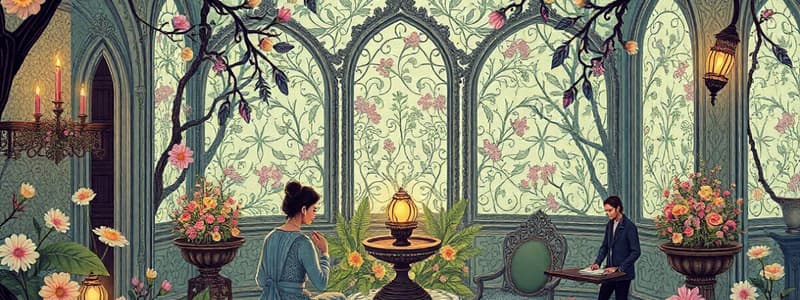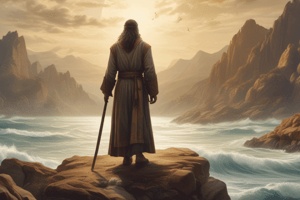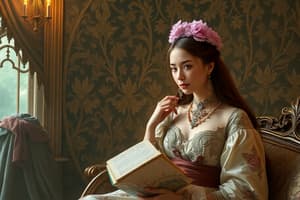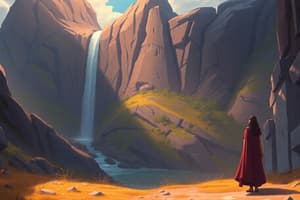Podcast
Questions and Answers
The setting of a story can include details about societal and cultural surroundings.
The setting of a story can include details about societal and cultural surroundings.
True (A)
Imagery is a technique used in describing characters' internal thoughts.
Imagery is a technique used in describing characters' internal thoughts.
False (B)
Minor themes are consistent throughout the entire literary work.
Minor themes are consistent throughout the entire literary work.
False (B)
Backdrop setting relates to unspecified or generalized times and locations.
Backdrop setting relates to unspecified or generalized times and locations.
Mood is related to the general atmosphere conveyed in a story through its wording and descriptions.
Mood is related to the general atmosphere conveyed in a story through its wording and descriptions.
Fictions are always based on true events only.
Fictions are always based on true events only.
Imagery is used in narratives to appeal to the reader's senses.
Imagery is used in narratives to appeal to the reader's senses.
Modern fiction never uses elements from traditional fairy tales.
Modern fiction never uses elements from traditional fairy tales.
Similes use the terms 'like' or 'as' to draw comparisons.
Similes use the terms 'like' or 'as' to draw comparisons.
The Bible has no influence on modern fiction.
The Bible has no influence on modern fiction.
Flashcards
Fiction writing
Fiction writing
An art form where a writer creates imaginary narratives.
Writing style
Writing style
The unique way a writer uses words in a narrative.
Diction
Diction
The choice of words used by a writer in their narrative.
Imagery
Imagery
Signup and view all the flashcards
Symbolism
Symbolism
Signup and view all the flashcards
Setting
Setting
Signup and view all the flashcards
Theme
Theme
Signup and view all the flashcards
Backstory vs. Plot
Backstory vs. Plot
Signup and view all the flashcards
Major vs. Minor Themes
Major vs. Minor Themes
Signup and view all the flashcards
Study Notes
Setting in Stories
- Setting encompasses time, place, and duration of a story.
- Place can be real or imagined.
- Time can be past, present, or future.
- Authors use details like landscape, climate, and societal aspects to create a setting.
- Techniques like imagery and exposition establish the setting.
- Imagery is descriptive; exposition introduces characters, time, place, and general information.
Types of Setting
- Backdrop Setting: vague time and place.
- Temporal Setting: focuses on the time period (e.g., Victorian Era).
- Environmental Setting: focuses on the location (e.g., Middle East).
- Individual Setting: specific locations and times (e.g., grandma's house).
Story Elements
- Characters, plot, conflict, resolution, and setting are vital parts of a story.
Theme in Literature
- Themes are overarching ideas or concepts in a literary work.
- Major themes run throughout an entire piece; minor themes are specific to sections.
- Themes often stem from personal experiences or opinions.
- Examples include love, redemption, forgiveness, coming-of-age, revenge, good vs. evil, bravery, and survival.
Distinguishing Theme from Other Literary Devices.
- Theme is distinct from morals, mood, and subject.
- Morals are specific lessons for readers (e.g., "don't judge a book by its cover").
- Mood is the overall atmosphere of a work, conveyed by words and descriptions (e.g., "cheerful" mood).
- Subject is the foundational, central topic of a story (e.g., religion in "The DaVinci Code").
Fiction Writing and Style
- Fiction writing uses imagination, but reality can inspire it.
- Writing style is how a writer uses words in a narrative.
- Styles reveal a writer's identity and information about characters, setting, and plot.
- Literary techniques used in style include:
- Diction: word choice.
- Figurative language including imagery, similes, and symbolism.
- Imagery: descriptive language appealing to senses.
- Similes: comparisons using "like" or "as."
- Symbolism: using concrete objects to represent abstract ideas.
Modern Fiction's Sources
- Modern fiction often draws from myths, traditional stories, and religious works (especially the Bible).
Myths
- Myths are ancient stories about gods and heroes, which provide insights into the world, human nature, and relationships.
- Examples include: Rick Riordan's Percy Jackson, J.K. Rowling's Harry Potter, and J.R.R. Tolkien's Hobbit and Lord of the Rings.
Traditional Stories
- Traditional stories include fairy tales and fables.
- Fairy tales involve kings, princesses, tricksters, and magical creatures.
- Fables use animals to teach lessons about right and wrong.
- Examples include Harry Potter series, Disney tales, and Twilight series.
The Bible
- The Bible is a major religious text that records God's interactions with people.
- Biblical figures and themes appear in modern works like Harry Potter, Narnia, and Lord of the Rings.
Studying That Suits You
Use AI to generate personalized quizzes and flashcards to suit your learning preferences.




